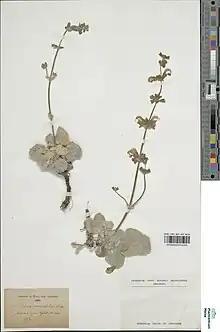| Salvia veneris | |
|---|---|
 | |
| Scientific classification | |
| Kingdom: | Plantae |
| Clade: | Tracheophytes |
| Clade: | Angiosperms |
| Clade: | Eudicots |
| Clade: | Asterids |
| Order: | Lamiales |
| Family: | Lamiaceae |
| Genus: | Salvia |
| Species: | S. veneris |
| Binomial name | |
| Salvia veneris Hedge | |
| Synonyms | |
|
Salvia crassifolia Sibth. & Smith | |
Salvia veneris, the Kythrean sage, is a species of flowering plant in the family Lamiaceae that is endemic to Cyprus. It is found in a very small area just west of the village of Kythrea. A study in 2004 found only approximately 4,000 surviving plants.
Salvia veneris has felt-like leaves growing in a basal rosette. The flowers are bi-colored, with the upper lip blue and the lower lip white with pale yellow markings. The stems give off a pleasant fragrance when crushed. The basal rosette leaf habit is unusual in the genus Salvia, and is thought to be an adaptation to grazing by goats.
References
- ↑ Viney, D.E.; Christofides, Y.; Kadis, C. (2006). "Salvia veneris". IUCN Red List of Threatened Species. 2006: e.T61665A12534804. doi:10.2305/IUCN.UK.2006.RLTS.T61665A12534804.en. Retrieved 16 November 2021.
Sources
- de Montmollin, Bertrand; Wendy Strahm (2005). IUCN/SSC Mediterranean Islands Plant Specialist Group (ed.). The top 50 Mediterranean Island plants: wild plants at the brink of extinction, and what is needed to save them. IUCN. ISBN 978-2-8317-0832-4.
This article is issued from Wikipedia. The text is licensed under Creative Commons - Attribution - Sharealike. Additional terms may apply for the media files.
